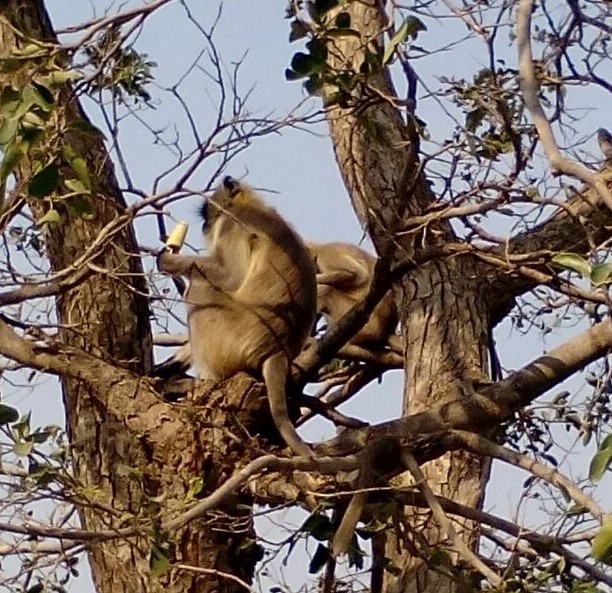Animal behavior fascinates me, and I mean beyond yawning-cat and sneezing-panda videos. Animals are supposedly free of rules that have been attributed solely to humans. Yet, they follow their own rules of social conduct, communication signals, and to a certain extent, emotions. Monkeys are especially entertaining, being genetically so close to us, but free to drop the facade of shame or social etiquette as needed. This was one such notorious monkey in Jaipur; look at him enjoying an ice cream that he stole from a tourist, moments before this photo was captured.

As I observed how he held it perfectly, clearly having seen others do it before, I thought of the common phrase ‘monkey see, monkey do’ that we usually associate with imitation. My research led to an interesting factoid: the term is not directly related to imitation.
It was about 20 yrs ago that a group of researchers were studying the brain activity of monkeys associated with their motor skills [1]. They basically observed the firing of individual neurons (brain cells), whenever the monkeys picked up a peanut. Interestingly, they saw that the same neuron lights up even when the human researchers picked up the peanut to hand it to the monkey. This meant these brain cells did not differentiate between actually doing an action from watching others do it; hence, monkey see, monkey do.
These neurons, called mirror neurons, gained wide popularity as researchers tried to extrapolate their functions in humans. They wondered if mirror neurons could explain empathy: an emotion that we feel based on someone else’s situation, even when we do not physically experience it. A common example of empathy is infectious laughter that catches on when you see someone else laugh uncontrollably. Want another example? Check this video.
The issue in proving their role in humans is that it is difficult to insert electrodes into our brains to see single neuron activity, as reported for monkeys. So most human experiments are based on fMRI imaging, which can show similarities in active brain areas while performing/visualizing tasks, but cannot conclusively prove it at a single neuron level (like in monkeys) [2].
As goes with most high profile research, this hype went out of hand, and mirror neurons were even used as the explanation for complex processes, such as the development of language. Or the lack of these apparently providing answers for little-understood problems like autism. Extrapolation of association as causation is exactly what results in larger-than-life inaccurate scientific interpretations.
Bottom line: the function of mirror neurons in humans is not yet clearly understood. One experiment that actually recorded single neuron data from neurosurgical patients did find evidence of mirror neurons [3], so there is always hope and scope for progress. What remains a mystery for me is why, in this particular case, seeing someone else eat ice cream was not the equivalent of doing it for this monkey?
References
- Gallese, Vittorio, et al. “Action recognition in the premotor cortex.” Brain119.2 (1996): 593-609.
- Kilner, James M., and R. N. Lemon. “What we know currently about mirror neurons.” Current Biology 23.23 (2013): R1057-R1062.
- Mukamel, Roy, et al. “Single-neuron responses in humans during execution and observation of actions.” Current biology 20.8 (2010): 750-756.

Great readng abt monkeys !! … Research is no ordinary “monkey business” is it ?
As I feel it , I think every action ( actual) happens first in the mind and then materializes ! Its the ” thought” that is generated first in the mind which may lead to actual execution . So since monkeys r said to experience emotions ( atleast some !) is it possible that animals- atleast monkeys –have a mind of their own ? I Heard animals have brains & just instincts !! No mind ! Whatever emotions they feel – cud they be bcos of what we call ” Sahaj pravrutti ” — natural tendency ?? Now the big question for a layman like me is not abt the neurons etc. but ” what is it that generates a THOUGHT in the first place , which leads to all the cell reactions in the brain !!
LikeLike
Yes, its a very complicated process indeed! 🙂 They definitely have a mind of their own and do not react randomly to situations. Glad you enjoyed the read 🙂
LikeLike
Hey good one as always
LikeLike
Hey good one as always…
LikeLiked by 1 person
thank you 🙂
LikeLike
I liked this post very much! I didn’t know this story about how they found the mirror neurons 🙂
PS. Thanks for making me start yawning, now I can’t stop!
LikeLike
thanks! 🙂 haha, you have too much empathy then 😛
LikeLike
Good but could be better.
LikeLike
Thanks, good to have your feedback
LikeLike